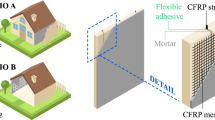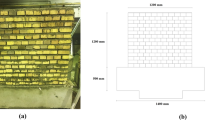Abstract
Traditional non-reinforced masonry walls are particularly prone to failure when subjected to out-of-plane loads and displacements caused by earthquakes. Moreover, singularities such as openings in façades may trigger local collapse, for either in-plane or out-of plane motion. Bearing in mind all the former limitations, STAP, with the scientific support of ICIST and LNEC, has been developing a reduced intrusiveness seismic strengthening methodology for traditional masonry structures. The technique consists in externally applying Glass Fibre Reinforced Polymer (GFRP) composite strips to one or both faces of walls. Connection between GFRP composite strips and masonry substrate is enhanced through specifically detailed anchorages or confinement connectors. This technique has been developed and studied through an extensive series of experimental tests, which are briefly reviewed. This paper focuses more deeply on the latest experimental program, aimed at the characterization of the masonry-GFRP composite interface behaviour. This testing program comprised 29 masonry specimens, strengthened with externally bonded GFRP composite strips with anchorages. The testing variables were the number and spacing of anchorages as well as the loading history type: monotonic or repeated. Results clearly show that the use of anchorages dramatically enhances bond behaviour and that its number and spacing have a significant effect on deformation capacity and a less pronounced effect on strength. Based on experimental evidence, this paper also provides a calculation model and ULS safety assessment procedure for out-of-plane strength of reinforced masonry walls. This calculation model leads to interaction curves on strengthened masonry walls subjected to compression and out-of-plane flexure.
Similar content being viewed by others
References
ACI (American Concrete Institute) (2007) Report on Fibre-Reinforced Polymer (FRP) reinforcement for concrete structures. Reported by ACI Committee 440 ACI 440R-07
Campos-Costa A, Candeias P, Massena B (2001) Ensaios sísmicos de estruturas de alvenaria de pedra, 3a Fase—Caracterização do comportamento de nembos em alvenaria de pedra reforçada para cargas repetidas e alternadas—Modelos M8, M9, M10 e M11—2a Técnica de reforço. Report 244/01, LNEC, Lisbon, Portugal (in Portuguese)
Candeias P, Campos-Costa A, Coelho E (2004) Shaking table tests of 1:3 reduced scale models of four story unreinforced masonry buildings. In: Proceedings of the 13th world conference on earthquake engineering. Vancouver, Canada
Candeias P, Coelho E, Campos-Costa A (2006) Shaking table tests of 1:3 scale models of 4 stories URM buildings: model analysis and vulnerability assessment. In: Proceedings of the 1st European conference on earthquake engineering and seismology. Geneva, Switzerland
Cardoso J (2008) Análise de uma solução de reforço sísmico de paredes de alvenaria tradicional com GFRP e ancoragens. Ensaios de aderência e modelo de cálculo. MSc thesis in Civil Engineering, IST TU Lisbon, Portugal (in Portuguese)
Cardoso J, Proença J, Gago A, Cóias e Silva V, Paula R (2008) Development of a reduced intrusiveness seismic strengthening technique in traditional masonry walls through GFRP strips and anchorages. Bonding tests and design model. In: Proceedings of the international seminar on seismic risk and rehabilitation of stone masonry housing. Faial, Azores, Portugal
Chen J, Yang Z, Holt G (2001) FRP or steel plate to concrete bonded joints: effects of test methods on experimental bond strength. Steel Compos Struct 1(2): 231–244
CML (Câmara Municipal de Lisboa) (2005) Diagnóstico Sócio-urbanístico da Cidade de Lisboa. Uma perspectiva censitária. Ed. Câmara Municipal de Lisboa, Lisbon, Portugal (in Portuguese)
CNR (National Research Council) (2004) Guide for the design and construction of externally bonded FRP systems for strengthening existing structures: materials, RC and PC structures, masonry structures. CNR-DT 200/2004, Italy
Cóias e Silva V (2001) Preserving baixa pombalina trough low intrusive seismic rehabilitation methods—The COMREHAB Project. In: Proceedings of the international congress UNESCO-ICOMOS. Paris, France
Cóias e Silva V (2007) Reabilitação Estrutural de Edifícios Antigos—Alvenaria, Madeira—Técnicas pouco intrusivas. Ed. Argumentum & Gecorpa, Lisbon, Portugal (in Portuguese)
FIB (Fédération Internationale de Béton) (2001) Externally bonded FRP reinforcement for RC structures. Bulletin N. 14, Lausanne, Switzerland
Gago A, Proença J, Cardoso J, Cóias V, Paula R (2009) Seismic strengthening of stone masonry walls with glass fibre reinforced polymer strips and mechanical anchorages. Expe Tech Soc Exp Mech (in press)
ISO (International Organization for Standardization) (1993) Standard 527-1:1993: plastics—determination of tensile properties—part 1: general principles. Geneva, Switzerland
ISO (International Organization for Standardization) (1997a) Standard 527-4:1997: plastics—determination of tensile properties—part 4: test conditions isotropic and orthotropic fibre-reinforced plastic composites. Geneva, Switzerland
ISO (International Organization for Standardization) (1997b) Standard 527-5:1997: plastics—determination of tensile properties—part 5: test conditions for unidirectional fibre-reinforced plastic composites. Geneva, Switzerland
Jifu L, Ming L, Yupu S (2007) Experimental investigation on flexural performance of masonry walls reinforced with GFRP. J Wuhan Univ Technol Mater Sci Ed 22(1): 82–84
Kiss RM, Jai J, Kollar LP, Krawinkler H (2002a) FRP strengthened masonry beams. Part I—model. J Compos Mater 36(5): 521–536
Kiss RM, Jai J, Kollar LP, Krawinkler H (2002b) Masonry strengthened with FRP subjected to combined bending and compression, part II—test results and model predictions. J Compos Mater 36(9): 1049–1063
LNEC (Laboratório Nacional de Engenharia Civil) (1993) E226 standard: Betão. Ensaio de compressão, Lisbon, Portugal (in Portuguese)
S&P - Clever Reinforcement Company (2002) Design guide line for S&P FRP systems. Switzerland
Tumialan JG, Galati N, Nanni A (2003) Fiber-reinforced polymer strengthening of unreinforced masonry walls subject to out-of-plane loads. ACI Struct J 100(3): 321–329
Yao J, Teng JG, Chen JF (2005) Experimental study on FRP-to-concrete bonded joints. J Compos Part B Eng 36(2): 99–113
Author information
Authors and Affiliations
Corresponding author
Rights and permissions
About this article
Cite this article
Proença, J., Gago, A.S., Cardoso, J. et al. Development of an innovative seismic strengthening technique for traditional load-bearing masonry walls. Bull Earthquake Eng 10, 113–133 (2012). https://doi.org/10.1007/s10518-010-9210-x
Received:
Accepted:
Published:
Issue Date:
DOI: https://doi.org/10.1007/s10518-010-9210-x




